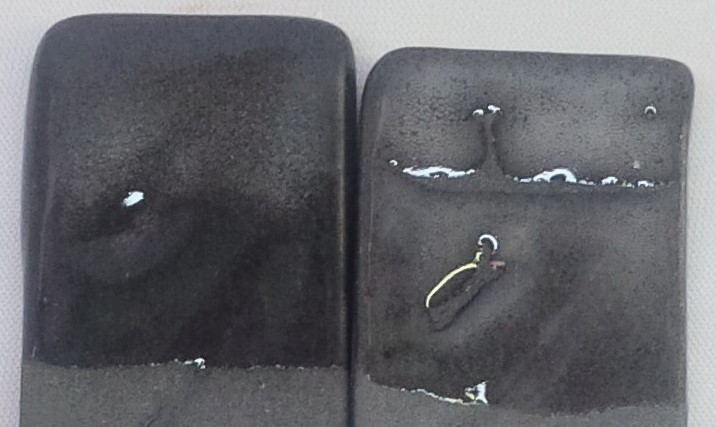| Monthly Tech-Tip | No tracking! No ads! | |
All Temperature Numbers Temperature Listing
1065-1120C (1949-2048F)
Body decomposition causes glaze bubbles
Terra cotta and even high-kaolin white burning bodies can fill transparent glazes with clouds of tiny micro-bubbles, impairing the clarity of the glass.
Related Information
Why is this transparent so full of bubbles?

This picture has its own page with more detail, click here to see it.
An example of how a micro-bubble population in the matrix of a transparent glaze can partially opacify it. If this glaze was completely transparent, the red clay body would show much better. However this is not the fault of the glaze. On a white body it would be more transparent. The problem is the terra cotta body. This is fired at cone 02. As the body approaches vitrification the decomposition of particles within it generate gases that bubble up in to the glaze. A positive aspect of this phenomena that this glaze could be opacified using a lower percentage of zircon.
This type of glaze responds better to opacifier additions.
Micro bubbles in low fire glaze. Why?

This picture has its own page with more detail, click here to see it.
Left: G1916Q transparent fired at cone 03 over a black engobe (L3685T plus stain) and a kaolin-based low fire stoneware (L3685T). The micro-bubbles are proliferating when the glaze is too thick. Right: A commercial low fire transparent (two coats lower and 3 coats upper). A crystal clear glaze result is needed and it appears that the body is generating gases that cause this problem. Likely the kaolin is the guilty material, the recipe contains almost 50%. Kaolin has a 12% LOI. To cut this LOI it will be necessary to replace some or all of the kaolin with a low carbon ball clay. This will mean a loss in whiteness. Another solution would be diluting the kaolin with feldspar and adding more bentonite to make up for lost plasticity.
| By Tony Hansen Follow me on        |  |
Got a Question?
Buy me a coffee and we can talk

https://digitalfire.com, All Rights Reserved
Privacy Policy
